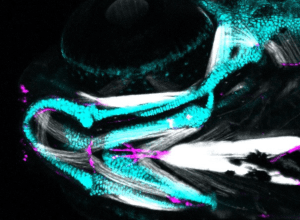
A USC-led team of scientists has made a drool-worthy discovery about how tendons and salivary glands develop in the jaw. Their results are published in a new study in Developmental Cell.
In order for our jaws to function, they require not only a precisely patterned skeleton, but also tendons that connect the jaw skeleton to muscles and salivary glands that lubricate the mouth. Remarkably, the skeleton, tendons, and glands all derive from the same population of stem cells, which arise from a cell population known as neural crest. How these neural crest-derived cells know to make the right type of cell in the right location has remained a mystery.
To begin answering this question, first author Hung-Jhen (Olivia) Chen from the lab of corresponding author Gage Crump, professor and vice-chair of stem cell biology and regenerative medicine at USC at the Keck School of Medicine of USC, and colleagues examined all the genes that were active in the developing face of zebrafish. They then honed in on one particular gene, Nr5a2, that was active in a region of the face that makes tendons and glands, but not skeleton.
To understand the role of Nr5a2, the scientists created zebrafish lacking this gene. These mutant zebrafish generated excess cartilage and were missing tendons in their jaws.
To read more, visit https://stemcell.keck.usc.edu/how-to-assemble-a-complete-jaw/.